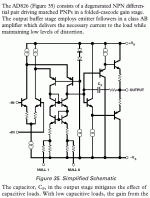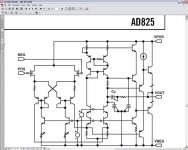peranders,
sure it gets warm to the touch after a couple of minutes, but the sound is not there until after at least 15-20 minutes, and after an hour I never hear a problem.
The sound of the DAC the first minutes after I turn it on is hard, cold, and generally unpleasant to listen to.
I don´t have the slightest idea why it is so, but it is.
/Peter
sure it gets warm to the touch after a couple of minutes, but the sound is not there until after at least 15-20 minutes, and after an hour I never hear a problem.
The sound of the DAC the first minutes after I turn it on is hard, cold, and generally unpleasant to listen to.
I don´t have the slightest idea why it is so, but it is.
/Peter
Pan said:The sound of the DAC the first minutes after I turn it on is hard, cold, and generally unpleasant to listen to.
I don´t have the slightest idea why it is so, but it is.
Do this experiment in order to establish feellngs (or is it emotions) from facts:
Let your friend/wife/girlfriend/mom/dad etc call you randomly after they have put the gear on. They won't tell you how long it has been switch on. If you always (>70%) can pick "the long time" from short then you obviously have a problem, otherwise it's only in your head.
peranders,
no, no,
this is such a big difference you don´t even bother to do a blind test.
The same goes for my Zapsolute mono blocks, they do not have full sound quality the first 30-60 min or so when turned on.
A couple of years ago I used a Aleph 5 for a weekend and that amp also needed an hour or so to open up.
There are many things I do not have an exlanation to, but it´s real anyway. Long time ago I hardly believed in the audible difference betweeen cables. After my system became "high resolution" cables do sound different.
Also this thing about burn in, I didn´t really believed in it since I had never experienced it myself. I remember my Sonus Faber got a little warmer with more bass after a couple of weks (years ago).
I also was surprised when I modded my SCD-XB940 with the LClock and Zapfilter a year ago or so.
After the first modd (the clock) my jaw dropped because of the improvement. After the Zapfilter was installed, I was a little like "hmmm...." I was not really sure the sound was a big improvement over the opamps that I disconnected. After 4-8 hours the sound became warmer and more natural with higher resolution. After a couple of days the improvements went on to stabilize completely after 4-8 days or so.
This was very obvious, also to a friend of mine who is allergic to cold analytical sound, after the Zapfilter was "burned in" the sound was warm open and clean, almost "tube like".
Audio is fun!
/Peter
no, no,
this is such a big difference you don´t even bother to do a blind test.
The same goes for my Zapsolute mono blocks, they do not have full sound quality the first 30-60 min or so when turned on.
A couple of years ago I used a Aleph 5 for a weekend and that amp also needed an hour or so to open up.
There are many things I do not have an exlanation to, but it´s real anyway. Long time ago I hardly believed in the audible difference betweeen cables. After my system became "high resolution" cables do sound different.
Also this thing about burn in, I didn´t really believed in it since I had never experienced it myself. I remember my Sonus Faber got a little warmer with more bass after a couple of weks (years ago).
I also was surprised when I modded my SCD-XB940 with the LClock and Zapfilter a year ago or so.
After the first modd (the clock) my jaw dropped because of the improvement. After the Zapfilter was installed, I was a little like "hmmm...." I was not really sure the sound was a big improvement over the opamps that I disconnected. After 4-8 hours the sound became warmer and more natural with higher resolution. After a couple of days the improvements went on to stabilize completely after 4-8 days or so.
This was very obvious, also to a friend of mine who is allergic to cold analytical sound, after the Zapfilter was "burned in" the sound was warm open and clean, almost "tube like".
Audio is fun!
/Peter
Jonathan> I found about 1k ohm was enough resistence. I thought as you did at first that the current woiuld varry as per applyed Voltage from the signal so i placed a volt Meter across the Series resistor with a signal in the Audio range from a few mV to the Clipping point and the DC Voltage across the series resistor was constant. so i would asume the DC current would be also. I have tried alot of Different Current sources to Bias an opamp into Class A and a cascode Jfet supplying from 1-5 mA with a 1K series resistor was the only topology that was transparent to the Audio signal. Meaning that by switching any Current source on and off in the circuit the sound got alot smoothrer with it on but in most other artifacts were also added like reduced dynamics, or strange Mid and high frequency artifacts and loss of detail. The jfet cascode on the otherhand dod none of those things just smooth out the rought edges of the sound yet still retain detail and dynamic Punch. BTY I also agree with you that the bad rap that opamps get is mostly due to Improper application.
ALW>"Thanks for that post, my experience of the AD797 was as a drop-in listening test to a simple headphone amplifier"
I thought you were refering to the 797 as used in a lower gain stage than a headphone Amp. Both the AD-797 and the LT-1028 do not soud so good in these types of low gain line level stages. hear I would use the AD-8610/20.
ALW>"Thanks for that post, my experience of the AD797 was as a drop-in listening test to a simple headphone amplifier"
I thought you were refering to the 797 as used in a lower gain stage than a headphone Amp. Both the AD-797 and the LT-1028 do not soud so good in these types of low gain line level stages. hear I would use the AD-8610/20.
ppl: 1k? Considerably higher than I thought.
When I tested the current-regulator diodes, I just put varying amounts of DCV across them, and checked the current at each voltage. The smaller values are fairly linear, but the higher values definitely show a curve - little current at low DCV, fairly rapid ramp-up to the rated current output at some voltage, and a more gradual fall-off at higher DCVs. I almost always secure any CR diodes that I use with a complex BJT cascode so they get exactly the voltage that I want them to see, but if you don't cascode, it is better to run the voltage a little high.
regards, jonathan carr
When I tested the current-regulator diodes, I just put varying amounts of DCV across them, and checked the current at each voltage. The smaller values are fairly linear, but the higher values definitely show a curve - little current at low DCV, fairly rapid ramp-up to the rated current output at some voltage, and a more gradual fall-off at higher DCVs. I almost always secure any CR diodes that I use with a complex BJT cascode so they get exactly the voltage that I want them to see, but if you don't cascode, it is better to run the voltage a little high.
regards, jonathan carr
Could you post a schematic of this idea sounds interesting Although i have cascoded A jfet to a 1N5309 from the then Motorolla now on semi. and below about 5 Volts the curent would drop about 10% But i found that cascoding a Matched pair of J-fets in cascode and got within 1% from The 0.2mA devices and well as the 3.5 ma Pair this was maintained from just above 3 VDC to 18 VDC. This also acomidated the amplifier driven to Clipping at the Respective supply Voltages. This to me is pretty dan good Performance No?
AD826 & AD797 - High Class Bipolar Opamps
which can be considered having Very High performance.
They have actually very much in common
when you look closely at the simplified schematics
that are in the datasheets.
-----------------------------
They are bipolar.
They have only 2 stages before the complementary output buffer.
- First stage longtailed NPN pair,
feeding the other stage, which is a Common Base Pair.
In this stage, via a current mirror,
the resulting current is put out to the Buffer.
----------------------------
Only 2 stages and common base - fast opamps.
Compared to for example the interior of NE5534
this is a very simple and beautiful design.
/halojoy - likes AD797 and AD826 (well, not the price)
Both AD826 & AD797 are Bipolar OpampsWombat said:Did you try the AD826. If you like compatiliby it has to be at least
+/- 15V and this is what i pray al the time.
which can be considered having Very High performance.
They have actually very much in common
when you look closely at the simplified schematics
that are in the datasheets.
-----------------------------
They are bipolar.
They have only 2 stages before the complementary output buffer.
- First stage longtailed NPN pair,
feeding the other stage, which is a Common Base Pair.
In this stage, via a current mirror,
the resulting current is put out to the Buffer.
----------------------------
Only 2 stages and common base - fast opamps.
Compared to for example the interior of NE5534
this is a very simple and beautiful design.
/halojoy - likes AD797 and AD826 (well, not the price)
Attachments
- Status
- This old topic is closed. If you want to reopen this topic, contact a moderator using the "Report Post" button.
- Home
- Amplifiers
- Solid State
- opa627ap/bp

